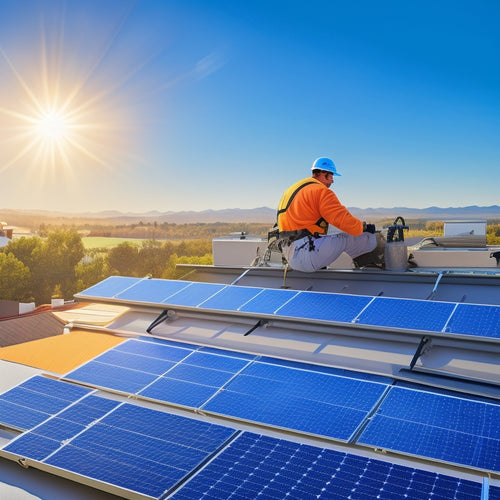
What Are the Requirements for Solar Power Electricity in Homes?
Share
You're considering utilizing solar power for your home, but what are the requirements to make it happen? To start, you'll need to assess your energy needs, reviewing past bills to determine your average daily usage. Your roof must be at least 500 square feet, south-facing, and free from obstructions like vents or chimneys. Local building codes and regulations must be met, and you'll need to choose the right solar panel system components, inverter, and battery. Electrical panel upgrades, net metering, and inspections are also vital. By satisfying these requirements, you'll be well on your way to capturing the sun's energy - and there's more to investigate to guarantee a smooth shift.
Key Takeaways
- Assess energy consumption patterns by reviewing past electricity bills and identifying opportunities for efficiency improvements.
- Ensure the roof meets size, orientation, and material requirements, with a minimum of 500 square feet and a suitable pitch.
- Comply with local building codes, obtain necessary permits, and meet utility company's technical standards for grid connection.
- Select certified solar panel system components, including panels, racking, and mounting hardware, that meet durability and weather resistance standards.
- Ensure inverter and battery requirements are met, including efficient DC-to-AC power conversion and sufficient battery capacity for backup needs.
Assessing Your Energy Needs
Before investing in a solar power system, it's essential to evaluate your energy needs to guarantee you're generating enough electricity to meet your daily requirements.
You'll want to analyze your energy consumption patterns to determine how much power you need. Start by reviewing your past electricity bills to identify your average daily energy usage in kilowatt-hours (kWh).
Consider factors like the number of occupants in your home, your appliances' energy efficiency, and your lighting usage. You may also want to investigate opportunities for efficiency improvements, such as replacing incandescent bulbs with LEDs or upgrading to energy-efficient appliances.
By understanding your energy needs, you can determine the appropriate size of your solar power system and verify it meets your energy demands. A properly sized system will maximize your energy independence and reduce your reliance on the grid.
Accurately evaluating your energy needs will help you design a solar power system that effectively powers your home.
Roof Size and Orientation
Assess your roof's size and orientation to determine its potential for hosting a solar power system. A suitable roof size is vital to accommodate the required number of solar panels. Generally, a roof with an area of at least 500 square feet is considered ideal. However, this can vary depending on the type and efficiency of solar panels you choose.
Consider the following factors to guarantee your roof is suitable for solar panels:
-
South-facing orientation: Ideal for maximum energy production, but east- and west-facing roofs can also work.
-
Unobstructed space: Guarantee a clear area for the solar panels, avoiding vents, skylights, and chimneys.
-
Roof material considerations: Asphalt shingles, metal, and concrete tiles are suitable for solar panels, but slate tiles may require additional structural support.
- Pitch and angle: A roof pitch between 15° and 40° is ideal, but some solar panel types can accommodate steeper or flatter angles.
Shading and Obstruction Factors
Ideal energy production from your solar power system hinges on minimizing shading and obstruction factors that can greatly reduce its efficiency.
You need to guarantee that your solar panels receive maximum sunlight exposure throughout the day. Shading from trees, buildings, or other structures can markedly impact your system's performance.
To mitigate this, a shading analysis is essential to identify potential obstacles and determine their obstruction impact on your solar panels.
This analysis takes into account factors like the time of day, season, and surrounding environment to provide an accurate assessment of shading effects.
Local Building Codes Compliance
Your solar power system must comply with local building codes to guarantee a safe and reliable installation. This involves obtaining necessary construction permits and adhering to local regulations.
Failure to comply can result in fines, penalties, or even system shutdown.
To ascertain compliance, consider the following:
-
Electrical code compliance: Confirm your system meets the National Electric Code (NEC) standards for electrical safety.
-
Structural integrity: Verify that your roof can support the weight of the solar panels and withstand environmental elements like wind and snow.
-
Fire safety: Validate your system meets local fire safety regulations, including clearance from flammable materials and access for firefighters.
- Zoning ordinances: Check local zoning laws to confirm your system complies with height, size, and setback requirements.
Solar Panel System Components
A solar panel system comprises several critical components that work in tandem to convert sunlight into usable electricity for your home. These components include solar panels, racking and tracking systems, and mounting hardware.
You'll need to choose from various solar panel types, such as monocrystalline, polycrystalline, or thin-film, each with its efficiency and cost benefits. The racking and tracking systems will affect the installation methods, which can be either roof-mounted, ground-mounted, or building-integrated. Roof-mounted systems are the most common, while ground-mounted systems offer more flexibility. Building-integrated systems, on the other hand, are designed to blend seamlessly with your roof.
When selecting components, consider factors such as durability, weather resistance, and compatibility with local building codes. Verify that your chosen components are certified by reputable organizations, such as the International Electrotechnical Commission (IEC) or Underwriters Laboratories (UL).
Inverter and Battery Requirements
The electrical heart of your solar power system, the inverter, converts DC power from the solar panels into AC power for your home's electrical grid. This vital component guarantees your home receives stable, usable electricity.
You'll need to take into account inverter types, such as string inverters, microinverters, or power optimizers, each with its own strengths and weaknesses.
When selecting an inverter, think about the following:
- Efficiency: How effectively does the inverter convert DC power to AC?
- Compatibility: Is the inverter compatible with your solar panel array and electrical grid?
- Monitoring: Can the inverter track performance and alert you to any issues?
- Warranty: What kind of warranty and support does the manufacturer offer?
Battery capacity is another significant aspect to take into account.
You'll need to determine how much energy storage you require, based on your energy usage patterns and backup needs. A properly sized battery bank will guarantee you have power during outages or when the sun isn't shining.
Electrical Panel Upgrades Needed
Solar power systems often require upgrades to your home's electrical panel to confirm a safe and efficient connection. This is because the panel may not be able to handle the increased power output from the solar system. Upgrades can improve panel efficiency, reducing the risk of electrical fires and guaranteeing a reliable connection.
Here is a breakdown of the possible upgrades you may need:
| Upgrade | Description |
|---|---|
| Main Panel Upgrade | Replaces the existing main electrical panel with a higher-capacity one to handle the increased power output from the solar system. |
| Subpanel Addition | Installs a new subpanel to handle the solar power output, reducing the load on the main panel. |
| Circuit Breaker Upgrade | Replaces existing circuit breakers with higher-capacity ones to handle the increased power output. |
| Busbar Upgrade | Upgrades the busbar (the electrical distribution point) to handle the increased power output. |
| Grounding System Upgrade | Upgrades the grounding system to confirm a safe and efficient connection. |
Keep in mind that installation costs will vary depending on the type and complexity of the upgrades needed. It's crucial to consult with a licensed electrician to determine the specific upgrades required for your home's electrical panel.
Net Metering and Interconnection
You'll need to maneuver through the requirements of your utility company to guarantee a successful solar power installation, which involves meeting specific standards for meter installation and grid connection.
Your utility company will have its own set of rules and regulations you'll need to follow, so it's crucial to understand their requirements before proceeding.
Utility Company Requirements
Before connecting your solar power system to the grid, you must comply with utility company requirements for net metering and interconnection.
These requirements guarantee a safe and efficient connection to the grid, allowing you to generate your own clean energy while still having access to the grid when needed.
To comply, you'll need to:
-
Obtain utility agreements: These agreements outline the terms and conditions of your connection to the grid, including energy tariffs and billing arrangements.
-
Meet interconnection standards: Your solar power system must meet the utility company's technical standards for interconnection, including voltage, frequency, and power quality requirements.
-
Install approved equipment: Your system must use equipment approved by the utility company, such as inverters and meters, to guarantee safe and reliable operation.
- Pass inspection and testing: Your system must pass inspection and testing by the utility company to guarantee it meets all safety and technical requirements.
Meter Installation Process
Now that you've satisfied the utility company's requirements, it's time to focus on the meter installation process, a critical step in connecting your solar power system to the grid.
This process involves installing a specialized meter that measures the electricity your system produces and feeds back into the grid. There are two main meter types: a bi-directional meter, which measures both incoming and outgoing electricity, and a production meter, which solely measures the electricity generated by your solar power system.
The installation timeline typically takes several weeks to a few months, depending on the utility company's workload and your system's complexity.
Once you've submitted your application, the utility company will schedule a site visit to assess your system and determine the necessary metering requirements.
After the meter is installed, you'll need to pass a final inspection before the utility company grants permission to operate (PTO) your system.
It's vital to coordinate with your utility company and installer to guarantee a smooth installation process and minimize any potential delays.
Grid Connection Standards
Grid connection standards, a crucial aspect of integrating solar power into the electrical grid, encompass net metering and interconnection agreements. These standards guarantee that your solar power system operates safely and efficiently while connected to the grid.
When connecting your solar power system to the grid, you'll need to comply with specific grid interconnection requirements. These requirements vary by utility company and region, but they typically include:
-
Safety standards: Your system must meet safety standards to prevent electrical shock, fires, and other hazards.
-
Grid interconnection requirements: Your system must be designed to synchronize with the grid's frequency and voltage.
-
Power quality standards: Your system must produce high-quality power that meets the grid's requirements.
- Monitoring and control systems: Your system must have monitoring and control systems to guarantee it operates within safe and efficient parameters.
Inspections and Permits Required
Typically, three to five inspections are required to confirm your solar power system meets local building codes and safety standards. These inspections are vital to guaranteeing your system is installed correctly and safely.
During the inspection process, local building authorities will verify that your system complies with relevant regulations and standards.
You'll need to obtain various permit types before and during the installation process. These permits may include electrical, building, and zoning permits.
The specific permits required vary depending on your location and local regulations. You'll need to submit plans and applications to obtain these permits, which may involve additional fees.
It's essential to work with a reputable solar installer who's familiar with local regulations and can guide you through the inspection and permitting process.
They'll confirm your system meets all necessary requirements, saving you time and potential penalties.
Frequently Asked Questions
Can I Install Solar Panels on a Metal or Clay Tile Roof?
You'll need to assess your metal or clay tile roof's weight and structural integrity before installing solar panels, considering installation considerations like anchor points and waterproofing to guarantee a secure and leak-free fit.
Do Solar Panels Work During Power Outages or at Night?
You might think solar panels are useless during power outages or at night, but with solar battery storage, you can capture energy even when the grid is down; grid-tied systems, however, won't function during outages, leaving you in the dark.
Are Solar Panels Resistant to Hail and Extreme Weather?
You'll be relieved to know that most solar panels are designed to withstand hail damage and extreme weather conditions, with some manufacturers testing their products to resist hailstones up to 1 inch in diameter.
Can I Install Solar Panels on a Rented Property?
Fast-forward to a sustainable future! You'll need to secure permissions from your landlord via renter agreements before installing solar panels on a rented property, ensuring a harmonious coexistence between eco-friendly goals and rental obligations.
Will Solar Panels Void My Roof's Warranty?
You're right to wonder if solar panels will void your roof's warranty; typically, they won't, but it depends on the roofing material and manufacturer's specifications. Ascertain your solar panel installation meets roof installation concerns and complies with solar panel warranties to avoid any issues.
Conclusion
As you consider utilizing solar power electricity in your home, remember that a thorough assessment of your energy needs, roof size, and local building codes is essential. Don't overlook shading and obstruction factors, as well as the importance of inverters, batteries, and electrical panel upgrades. After managing the necessary permits and inspections, you'll be generating clean energy in no time. Research suggests that homes with solar panels sell for up to $15,000 more than those without, making the investment a bright idea for your wallet too.
Related Posts
-

What You Need to Know About Permits and Inspections
You need to navigate the complex landscape of permits and inspections to guarantee your project complies with local z...
-

What You Need to Know About RV Solar Maintenance
When you're out on the road, your RV's solar panel system is your lifeline. But without regular maintenance, you're l...
-

3 Essential Steps for Solar Electricity Installation
To guarantee a successful solar electricity installation, you'll need to follow three essential steps. First, assess ...


